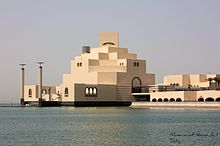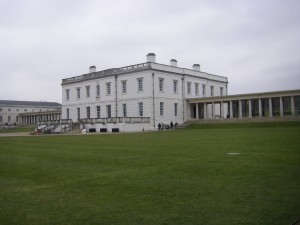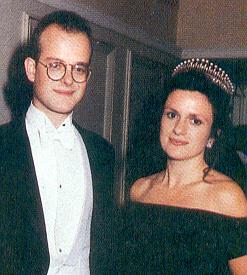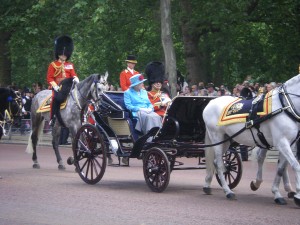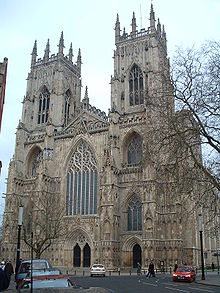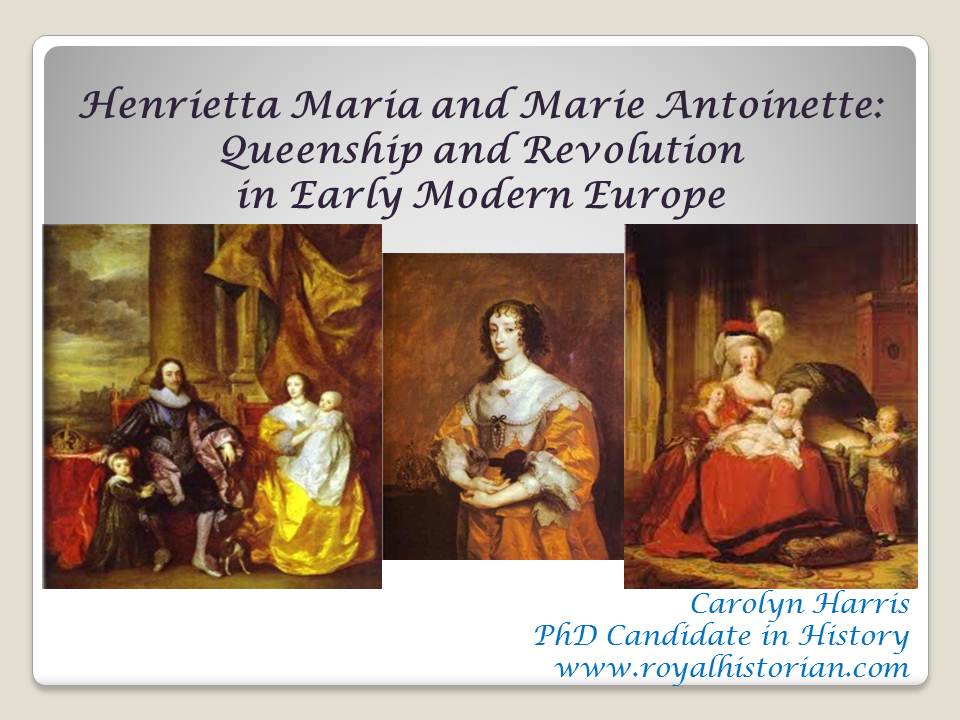 For those of you who will be in Kingston, Ontario next week, I will be discussing my PhD dissertation on Queen Henrietta Maria of England and Queen Marie Antoinette of France as part of the Queen’s University three minute thesis competition in the Biosciences Building Rm 1101 at 3:30pm on Thursday April 19. The format of the competition is for each participant to distill their research and its wider implications into a three minute talk. I hope to provide the essence how negative perceptions of Queen Henrietta Maria and Queen Marie Antoinette as wives, mothers and heads of royal households undermined monarchical government prior to the English Civil Wars and French Revolution. For more information on the Three Minute Thesis competition at Queen’s University, click here.
For those of you who will be in Kingston, Ontario next week, I will be discussing my PhD dissertation on Queen Henrietta Maria of England and Queen Marie Antoinette of France as part of the Queen’s University three minute thesis competition in the Biosciences Building Rm 1101 at 3:30pm on Thursday April 19. The format of the competition is for each participant to distill their research and its wider implications into a three minute talk. I hope to provide the essence how negative perceptions of Queen Henrietta Maria and Queen Marie Antoinette as wives, mothers and heads of royal households undermined monarchical government prior to the English Civil Wars and French Revolution. For more information on the Three Minute Thesis competition at Queen’s University, click here.
Yearly Archives: 2012
Sheikha Mayassa Al Thani of Qatar and the History of Royal Cultural Patronage

Sheikha Mayassa Al Thani, daughter of Sheikh Hamad bin Khalifa Al Thani, Emir of Qatar. Sheikha Mayassa is the head of the Qatar Museums Authority, which organizes acquisitions and exhibitions for the Museum of Islamic Art in Doha, Qatar.
This week’s Economist contains an extended feature article about Sheikha Mayassa, describing her as Qatar’s Culture Queen. The 29 year old Duke University graduate is Head of the Qatar Museums Authority (QMA), an agency independent of the Culture Ministry of Qatar. The autonomy of the QMA allows Sheikha Mayassa the freedom to realize her artistic vision on a grand scale. Sheikha Mayassa explained in her first major interview, “The QMA is very much my father’s baby. He wanted to create something…to connect with the community, to create a culture dialogue within society. We report directly to him. The nice thing about my father is that he doesn’t interfere in the day-to-day business. We present the strategy, and once he agrees with the strategy and the vision we are given the authority and freedom to go ahead and execute them in the way we think fit.” The Economist notes that the QMA budget is not disclosed to the public.
In contrast to the Emirs of the United Arab Emirates, who have created local franchises of the Louvre and Guggenheim Museums in Abu Dhabi, Sheikha Mayassa is overseeing the development of a unique regional museum. Exhibitions at the Museum of Islamic Art showcase the diversity of Middle Eastern art and culture. The museum’s opening exhibition, “Beyond Boundaries-Islamic Art Across Cultures” incorporated ceramics, metal work, manuscripts, jewellery and textiles from numerous regions including Syria, India, Spain and Uzbekistan. The Economist article discusses a recent exhibition of the ancient cultural connections between China and the Gulf states. Sheikha Mayassa and her family are also collectors of European art. The acquisition of Paul Cezanne’s “The Card Players” for $250 million set a new record in the international fine art markets.
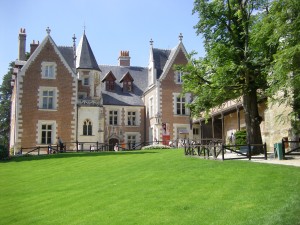
Clos Lucé, the home King Francois I provided for Leonardo da Vinci near his principal residence, the Chateau Amboise in France`s Loire Valley.
The scale of Sheikha Mayassa’s art collection is evocative of royal cultural patronage from 1500 to 1800. In the sixteenth century, Renaissance rulers sought to emphasize the wealth and sophistication of their court through patronage of the leading artists, musicians, scientists and philosophers. King Henry VIII of England famously sponsored the painter Hans Holbein and the writer Thomas More and composed his own music for the lute. His contemporary, King Francois I of France invited Leonardo da Vinci to relocate to the Loire Valley as a kind of artist in residence at the French court with the freedom to create works according to his interests. (da Vinci`s time in France is fictionalized in the film, Ever After: A Cinderella Story).
In the mid seventeenth century, King Charles I of England and his wife Henrietta Maria were the most active patrons of art and architecture. Since continental European rulers were devoting their expenditure to fighting the Thirty Years War, numerous artists and architects traveled to England during the 1620s and 1630s. Charles I was a patron of Antony Van Dyck and Peter Paul Rubens while Henrietta Maria commissioned Orazio Gentileschi and his daughter Artemesia to paint decorative ceilings in the Queen’s House at Greenwich. In the late eighteenth century, Catherine II “the Great” of Russia was the most prolific royal art patron, buying whole collections for the Hermitage on the advice of her learned correspondents including Denis Diderot, the editor of the Encyclopedia.

Sheikha Mayassa’s art patronage combines the grand scale of Early Modern royal art acquisition with the interest in accessibility displayed by present day constitutional monarchs. The Museum of Islamic Art in Doha, Qatar reflects her passion for art collection and showcasing the history and culture of the Gulf States.
The Duchess of Cornwall to be Patron of the Katherine Parr Quincentenary Festival at Sudeley Castle

The Gatehouse at Sudeley Castle near Winchcombe, Gloucestershire. Henry VIII's sixth wife Katherine Parr livedthere during her subsequent marriage to Thomas Seymour.
2012 marks the 500th birthday of Katherine Parr, Henry VIII’s sixth wife. Katherine famously survived Henry and then married the handsome Thomas Seymour (brother of Henry VIII’s third wife Jane Seymour) with “unseemly haste” after the King died in 1547. The couple settled at Sudeley Castle in the Cotswolds with a large household including Katherine’s ward, the thirteen year old future Queen Elizabeth I. While Katherine’s first three husbands had been arranged unions to much older men, her marriage to Thomas was a love match and the Dowager Queen intended for Sudeley Castle to be the place where they would raise their future children. Sadly, Katherine died in childbirth in 1548 and her daughter Mary Seymour did not long survive her. The castle came into the possession of Queen Mary I, who granted it to Sir John Brydges, the Lieutenant of Tower of London who attended Lady Jane Grey at the time of her execution. The castle currently belongs to Lord and Lady Ashcombe, who run it as both their home and a museum open to the public.

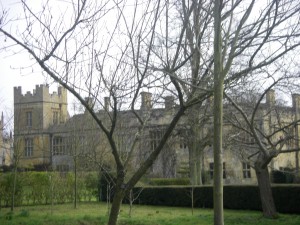
View of Sudeley Castle taken in March, 2009. The castle is open to the public seasonally from April to September.
The festivities in honour of Katherine Parr will have a royal patron, symbolizing Sudeley Castle’s long association with the monarchy. Her Royal Highness, the Duchess of Cornwall stated on becoming the patron of the Quincentenary Festival, “With over a thousand years of history, Sudeley Castle has many stories to tell; but none greater and more inspiring than that of its most famous Tudor resident, Queen Katherine Parr. Having spent many happy times at Sudeley, I am delighted to be Patron of this Festival which will unravel the fascinating life of this historic female character and share it with all who visit the very place where she lived, loved and died in the five hundred year anniversary of her birth.”

Queen Elizabeth II’s second great-grandchild Isla Elizabeth Phillips born March 29, 2012: Canadians in the Royal Family
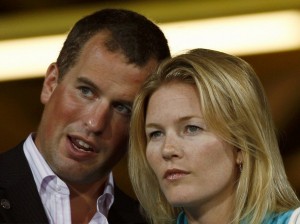
Peter Phillips, son of Princess Anne and eldest grandchild of Queen Elizabeth II attending the 2008 Paralympic Games in Beijing with his wife, Autumn. Mrs. Phillips was born Autumn Kelly in Montreal.
Queen Elizabeth II became a great-grandmother for the second time last Thursday with the birth of Isla Elizabeth Phillips, daughter of Princess Anne’s son, Peter Phillips and his wife Autumn. The couple also have an older daughter Savannah, who was born in 2010. Through her mother, baby Isla is the most recent member of the royal family with a direct Canadian connection. Autumn was born in Montreal in 1978 to Brian and Kitty Kelly. She graduated from McGill University in 2002 and met Peter Phillips at the Canadian Grand Prix in 2003.
Peter’s and Autumn’s 2008 wedding in St. George’s chapel, Windsor Castle drew attention to the terms of the 1701 Act of Settlement, which originally forbade the marriage of princes and princesses in line of succession with Roman Catholics. Autumn converted to the Church of England at the time of her wedding, allowing Peter to retain his status as 11th in line to the throne of the United Kingdom and sixteen commonwealth realms, including Canada. The Act was amended in 2011 to allow marriages between dynasts and Roman Catholics although the monarch must still be a member of the Church of England.
Autumn Phillips is the most famous Canadian born member of the royal family but she is not the only one. The Countess of St. Andrews, wife of George Windsor, Earl of St. Andrews, the eldest son and heir of Queen Elizabeth II’s cousin, the Duke of Kent, was born Sylvana Palma Tomaselli in Plancentia, Newfoundland in 1957. Although her family left Placentia when she was a child, they returned to Canada when she was a teenager. The Countess completed her Bachelor’s Degree at the University of British Columbia and Masters Degree at York University before moving to England, where she met the Earl of St. Andrews. They were married in 1988 and have three children, Lord Edward Windsor (Lord Downpatrick), Lady Marina-Charlotte Windsor and Lady Amelia Windsor. Like Peter and Autumn Phillips, the Earl and Countess of St. Andrews do not carry out royal duties but attend special events within the royal family and the annual Trooping of the Colour Parade. In contrast to Autumn, the Countess retained her Roman Catholic faith at the time of her marriage and her husband and children were therefore excluded from the line of succession until 2011.

The future Edward VIII as Prince of Wales in 1932. Edward purchased the Bendingfield ranch near Pekisko, Alberta during a tour of Canada in 1919.
While the current Queen’s Uncle, King Edward VIII was born in London, England, he acquired personal property during his extensive travels in Canada. In 1919, he became the owner of the Bedingfield Ranch in Alberta. It became known as the EP ranch. As Anne Sebba discusses in That Woman: The Life of Wallis Simpson, Duchess of Windsor, Edward wrote to his mistress Freda Dudley Ward in 1919 that if she would come live with him on his ranch, “I’d never want to return to England; I’ve got thoroughly bitten with Canada and its possibilities. It’s the place for a man, particularly after the Great War, and if I wasn’t PofW. well I guess I’d stay here quite a while.” The Canadian people reciprocated Edward’s enthusiasm and perceived him as a uniquely Canadian Prince. The 1936 Abdication crisis features in numerous works of Canadian literature, most notably Fifth Business by Robertson Davies and Famous Last Words by Timothey Findley. The Duchess of Windsor would observe after 1936 that the largest proportion of the angry letters she received from around the commonwealth were authored by Canadians who blamed her for the Abdication of their King.
The newborn Isla Elizabeth Phillips is the most recent member of the royal family with a direct link to Canada. Her mother, Autumn Phillips and the Countess of St. Andrews were both born and educated in Canada while Edward VIII owned personal property in Alberta. Queen Elizabeth II is not only Queen of Canada but the head of a family with extensive Canadian connections.
Changing the Experience at Kensington Palace

View of the entrance to Kensington Palace taken in January, 2009, before the recent refurbishment of the public galleries.
The state rooms of London’s Kensington Palace have recently been reopened to the public after a $20 million renovation project. Historic Royal Palaces, the charity that administers the public wing of the palace along with the Tower of London, Hampton Court, the Banqueting House at Whitehall and Kew Palace have unveiled a new stately entrance, new gardens and previously inaccessible areas such as the red saloon, when the eighteen year old Queen Victoria held her first meeting of the privy council. The new design of the museum includes art installations designed to help visitors navigate the palace and costumed staff to tell the stories of famous occupants such as Princess Diana and Queen Victoria. The private apartments will also be refurbished for new royal tenants. The Duke and Duchess of Cambridge will use the apartment that once belonged to the late Princess Margaret as their London residence (it is currently used for special exhibitions in the renovated museum).

Statue of Queen Victoria in Kensington Gardens, sculpted by her daughter Princess Louise, the Duchess of Argyll
Admirers of the renovations praise the new layout, accessibility and design of the palace museum. Unfortunately, these positive reviews have been accompanied by disproportionately negative descriptions of what the palace looked like before it was redesigned. Here in Canada, Patricia Treble of Maclean’s Magazine wrote that prior to the renovations, “After [tourists] plunked down $20 for an adult ticket, they got little for their money but a stroll through a confusing maze of rooms devoid of interesting features, listening to a boring commentary on what used to be here or was once there.” Having visited the palace in 2009 and taken the entire audio tour, I believe that this assessment is unfair. The former Kensington Palace museum clearly provided a different experience than the newly renovated space but it was still a fascinating and engaging place to visit.
After paying the reduced rate for my student ticket, I began on the garden floor, enjoying the ceremonial dress collection. There was interesting commentary about the difficulties reconciling changing court dress to twentieth century changing fashions. Attaching the a feathered headdress to a 1920s bobbed hairstyle was particularly difficult. A number of the late Princess Diana’s dresses were also on display with commentary on her decision to auction much of her 1980s wardrobe for her charitable causes.
The state rooms upstairs provided a glimpse of palace life in the time of King William III and Queen Mary II. After becoming King of England in 1688, William found that the sooty air around Whitehall Palace aggravated his asthma but Hampton Court was too removed from the seat of his government. The purchase of Kensington Palace combined fresh air with relative proximity to Westminster. William’s wife and co-ruler Mary devoted attention to refurbishing the gardens, commissioning the planting of centerfolia roses, which were much admired in the seventeenth century. The rooms where Queen Victoria spent her childhood in the early nineteenth century were also well presented, highlighting her difficult relationship with her mother, the Duchess of Kent.
In 2009, the special exhibition was “The Last Debutantes” about the final parade of unmarried aristocratic women presented to the sovereign in 1958. The galleries included dresses from the period, and interesting taped interviews with surviving debutantes, and the young men who danced with them during the social season. The exhibition sparked my interest in the experiences of these women and I read Fiona McCarthy’s fascinating account, Last Curtseyduring my time in London.
I look forward to seeing the renovated Kensington Palace the next time I visit London but will always have good memories of visiting the old palace museum.
The Diamond Jubilee Book Reviews 4: The Evolving Canadian Crown edited by Jennifer Smith and D. Michael Jackson


Joyal argues that the appointment of Canadian born Governors General has resulted in a “hybrid” system where the Queen actually reigns but her representative performs the crown’s duties in Canada. The most famous example of this interpretation of the Canadian crown is former Governor General Michaelle Jean’s 2009 speech before the United Nations cultural agency in which she described herself as Canada’s Head of State. Christopher McCreery effectively refutes this interpretation of the 1947 letters patent in the third chapter of The Evolving Canadian Crown.

One of the great strengths of The Evolving Canadian Crown is that it draws on the entire history of monarchy in Canada. The reader is reminded that New France was governed by the French crown until the territory was formally ceded to Great Britain under the 1763 Treaty of Paris, at the end of the Seven Years War. The book contains reproductions of the portraits of the French monarchs who were Kings of Canada, which are currently displayed in the Foyer and Salon de la Francophonie of the Canadian senate, as well as British monarchs from the eighteenth century to the present. The longstanding relationship between the Crown and Canada’s First Nations people is also covered in the chapter by David Arnot, reminding the reader that land treaties were negotiated directly with the crown.
The Evolving Canadian Crown places Canada within a comparative context, discussing how the monarchy is perceived in Australia and New Zealand. Australia has already held a referendum on the question of severing ties with the constitutional monarchy but Peter Boyce argues that this outcome is unlikely in the future, as Australia’s government and citizens have different views concerning the selection of a potential president of an Australian Republic.
In New Zealand, attitudes toward the crown are more positive, particularly as the structure of the modern state dates from the Treaty of Waitango between the Maori leaders and Queen Victoria. In New Zealand, as in Canada, there is a close relationship between the crown and original inhabitants of the state. These chapters of The Evolving Canadian Crownare fascinating and it would have been interesting to read additional pieces concerning the crown in the Caribbean particularly because Jamaica is considering becoming a republic on the 50th anniversary of the nation’s independence.
The Evolving Canadian Crownis a collection of thought provoking articles that demonstrate the continued relevance of the crown to Canada’s political system. The inclusion of comparative and historical pieces as well as essays about current events involving the Governor General will appeal to any reader interested in Canada’s government and history as well as the wider commonwealth.
If you are interested in receiving the latest updates to www.royalhistorian.com in your inbox, please provide your e-mail address in the box in the top right hand corner of the homepage.
Queen Elizabeth II, the Duke of Edinburgh and Princess Beatrice to attend Royal Maundy Service at York Minster, April 5, 2012
Queen Elizabeth II, the Duke of Edinburgh and their granddaughter Princess Beatrice will attend the Royal Maundy Thursday service at York Minster this Easter. This service was traditionally an opportunity for the poor to receive alms in the sovereign’s name but the current Queen has transformed the event into an opportunity to personally honour seniors who have contributed to their community and church. 86 men and 86 women, one for each year of the Queen’s age will receive a commemorative Diamond Jubilee coin and specially minted Maundy coins as keepsakes of the event. The structure of the Maundy service, the decision to hold this ceremony in York Minster and the presence of members of the extended royal family are all significant to the history and future of the royal family.
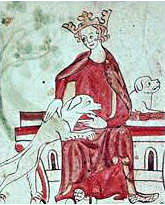
A thirteenth century image of King John, who reigned from 1199 to 1216, with his hunting dogs. John is the first recorded monarch to provide alms for the poor on Maundy Thursday.
Through her active participation in Maundy services, the Queen has revived a ceremony that received little interest from the monarchy between the reign of Queen Anne and the reign of George V. While there are recorded instances of churchmen washing the feet of the poor and providing Maundy Thursday alms since the 5th century, the first monarch to be involved in this ceremony was the notorious King John. In 1212, John gave thirteen pence to thirteen poor men in Rochester Cathedral. The distribution of these alms may have been an attempt to improve his reputation with his subjects and the clergy. John had been excommunicated by Pope Innocent III in 1208 for seizing church lands, and was widely unpopular for raising crippling taxes to first pay his brother King Richard’s ransom at the end of the Third Crusade then to fight a expensive war with France to attempt to regain the Duchy of Normandy.
John’s son Henry III and all his children participated in several Maundy celebrations each year, emphasizing the piety and humility of the royal family. Edward I “Longshanks” established the custom of only holding Maundy services on the Thursday before Easter and subsequent monarchs and consorts held more and more elaborate ceremonies. Although Mary I was Roman Catholic and Elizabeth I was Supreme Governor of the Church of England, both sisters held elaborate Maundy services, washing the feet of the poor (after they had been pre-washed three times by court servants and officials) and distributing extensive alms. Mary followed the example of her mother, Catherine of Aragon and gave the poorest woman present her own gown. James II was last monarch to actually wash the feet of the poor and the alms giving became less widespread in the eighteenth century.
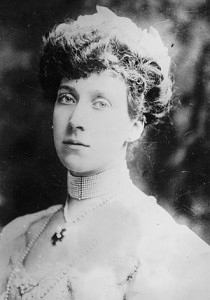
Princess Marie Louise of England, daughter of Prince Christian of Schleswig-Holstein and Princess Helena of the United Kingdom. Marie Louise attended Maundy Thursday services with her mother and suggested that George V participate in the almsgiving.
As discussed in Silver Pennies and Linen Towels: The Story of the Royal Maundy by Brian Robinson, royal participation in Maundy services ended in the eighteenth century with court officials providing the alms in the monarch’s name. Members of the extended royal family continued to attend the service, however, and in 1931, Princess Marie Louise suggested to her cousin, King George V that he might personally distribute the alms the following year. At that time, the recipients tended to be heads of households that had experienced unexpected financial difficulties. Elizabeth II eventually transformed the ceremony into a celebration of service to church and community.
York Minster cathedral has longstanding associations with the current British royal family. The second son of the monarch traditionally receives the title of “Duke of York” recalling the combined Lancaster and York descent of the Tudor dynasty, at the end of the Wars of the Roses in 1485. The Queen’s cousin, the Duke of Kent married Katherine Worlesley in York Minister in 1961 in the presence of the Queen, Prince Philip and Prince Charles. There had not been a wedding of a senior member of the royal family in York Minster since King Edward III married Princess Philippa of Hainault in 1328.
The attendance of Princess Beatrice at the 2012 Maundy Thursday service demonstrates her interest in carrying out royal duties. Queen Elizabeth II’s cousins, the Dukes of Kent and Gloucester and Princess Alexandra currently perform extensive royal duties but there is evidence that Prince Charles and Prince William intend to preside over a smaller group of active members of the royal family. Beatrice’s activities during the Diamond Jubilee celebrations may determine whether she spends her adult life as a working member of the royal family or if she persues an independent career as a private citizen.
The 2012 Maundy Thursday service at York Minster reflects Elizabeth II’s innovative approach to a centuries old royal tradition involving the sovereign and members of the royal extended family in the recognition of community service in York. The historic York Minster cathedral has long standing associations with the royal family and is the ideal setting for this ceremony.
The Tudor Book Reviews 2: Bessie Blount, the King’s Mistress by Elizabeth Norton



Norton does a masterful job of interpreting documents pertaining to the Blount family, Henry Fitzroy, and other sixteenth century court women to restore Bessie Blount to her rightful place in Tudor history. In Bessie Blount: The King’s Mistress, Bessie comes alive as one of the most beautiful women at Henry VIII’s court, sharing the King’s literary interests and taste for court pageantry despite her comparatively humble origins as a member of the Shropshire gentry. The birth of Henry Fitzroy encouraged the King to blame Catherine of Aragon for the absence of surviving sons in their marriage and believe that it might be possible to have male heirs with another wife.
While Edward IV’s illegitimate son, Arthur Plantagenet did not even receive a peerage from his royal father, Henry Fitzroy was made Duke of Somerset and Richmond and there were rumours he would be legitimized and made Henry VIII’s heir. Norton convincingly argues that Henry VIII may also have been the father of Bessie’s daughter, Elizabeth Tailboys, as the King took an unusual interest in this young woman’s marriage and property rights. Through her status as mother of King’s children, Bessie remained a notable figure at Henry VIII’s court even after his interest had shifted to the Boleyn sisters.
Bessie Blount: The King’s Mistress is not only the story of one woman’s rise to prominence at Henry VIII’s court but a case study of court politics in the sixteenth century. Bessie’s experiences were part of the Blount family’s attempts to increase their stature in the royal household through proximity to the King. Norton devotes considerable attention to her antecedents and the family of her eventual husband, Gilbert Tailboys, because family connections were critical to social advancement in Tudor times. Norton also uses Bessie as a lens for discussing the duties of ladies-in-waiting and the life cycle of a sixteenth century English noblewoman, providing a fascinating perspective of Tudor social history.
Bessie Blount: The King’s Mistress is an engaging and readable biography of an often overlooked figure at Henry VIII’s court. Norton effectively reconstructs the life and times of the King’s most prominent mistress revealing her historical significance and place within Tudor court politics.
Catherine, Duchess of Cambridge Makes Her First Public Speech at the East Anglia Children’s Hospice in Ipswitch
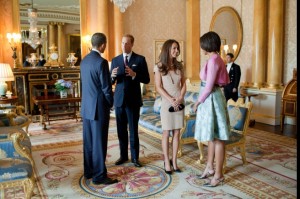
The Duke and Duchess of Cambridge meet with President Barack Obama of the United States and his wife Michelle. Since becoming a member of the royal family, Catherine has assumed an increasingly public profile.
On Monday March 19, Catherine, Duchess of Cambridge delivered her first public speech, launching the new East Anglia Children’s Hospices in Ipswitch. There was intense interest in her speech on behalf of this charity because Catherine has spoken so little in public during her marriage to Prince William. During the Duke and Duchess of Cambridge’s tour of Canada in 2011, Catherine had numerous private conversations with ordinary Canadians but William gave all the official speeches. This approach allowed the Duchess to adjust to her new public role.
In her speech in Ipswitch, Catherine had the opportunity to draw popular attention to a charity that she feels strongly about, stating “What you do is inspirational, it is a shining example of the support and the care that is delivered, not just here, but in the children’s hospice movement at large, up and down the country.” Catherine’s decision to become the patron of charity that provides end of life care for seriously ill children follows a long tradition of royal involvement in raising awareness of medical trends that improve the comfort and care of patients.



Through her patronage of the East Anglia Children’s Hospices, the current Duchess of Cambridge is following a long tradition of royal involvement in patient care. Queen Victoria’s daughters and granddaughters did not simply donate to hospitals but championed medical reform, actively involving themselves in improving the welfare of the sick and wounded. This conception of service monarchy clearly has a bright future in the twenty first century.
The Tudor Book Reviews 1: Sister Queens: The Noble, Tragic Lives of Katherine of Aragon and Juana, Queen of Castile



One of the great strengths of Sister Queens is Fox’s attention to the settings were these two princesses spent their lives. She has clearly traveled extensively in England, Wales and Spain and describes the Alhambra Palace in Grenada where Katherine and Juana spent part of their childhood, Ludlow Castle where Katherine lived during her brief time with Arthur and the numerous estates that comprised Katherine’s dower lands during her marriage to Henry VIII in exquisite detail. The households and responsibilities of both Katherine and Juana are also extensively discussed, revealing the precise responsibilities of a princess and queen in the sixteenth century.
Fox has a keen eye for the art and culture of sixteenth century European courts, describing the books owned by Catherine and Juana, the images woven into the tapestries in their chambers and the objects that decorated their palaces. This approach provides fresh insights into the worldview of two Spanish princesses who played such significant roles in the English and Flemish courts.
The sad life of Juana’s long life as the imprisoned Queen of Castile provides an effective counterpoint to Katherine’s experiences as Queen of England, revealing the challenges faced by royal women in a male dominated era of dynastic marriage. Juana has gone down in history as “Juana la Loca,” famously traveling around Spain with her husband’s coffin because she supposedly could not bear to be separated from his remains.

Sister Queens: The Noble, Tragic Lives of Katherine of Aragon and Juana, Queen of Castileis an engaging dual biography of two fascinating Queens that reveals the full complexity of their personalities and goals. Fox also provides as fascinating portrait of the art and culture of the sixteenth century courts of Europe, demonstrating that Katherine and Juana were cultural patrons as well as political figures.
